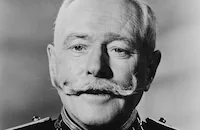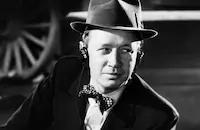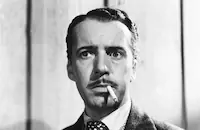Down to Earth

Brief Synopsis
Cast & Crew
Alexander Hall
Rita Hayworth
Larry Parks
Marc Platt
Roland Culver
James Gleason
Film Details
Technical Specs

Synopsis
When questioned by the police about the murder of gambler Joe Mannion, Broadway theatrical agent Max Corkle professes his innocence and tells the police lieutenant the story of how he came to know one of the gambler's associates, Danny Miller: While Danny, the director and leading actor of a musical show about the nine Greek muses, rehearses his play, Terpsichore, a real muse, high in the heavens on Mount Parnassus, becomes angered by actress Georgia Evans' vulgar portrayal of herself and vows to destroy Danny. Mr. Jordan, the man who oversees all travel from the heavens to earth, assigns Messenger 7013 to be Terpsichore's guide, and sends the two to Earth. In New York, Messenger 7013, who can be seen and heard only by Terpsichore, takes the muse to the Elton Theater, where Danny is rehearsing his show. Repulsed by Evans' performance, Terpsichore takes to the stage and shows off her singing and dancing abilities. Danny is enchanted by the mysterious actress, and later casts her in the role. Using the name Kitty Pendelton, Terpsichore hires Max Corkle as her agent and begins studying for her role. A short time later, Danny, who has fallen in love with Terpsichore, allows her to change her part from that of a "cheap trollop" to a more dignified muse. However, when the revamped show is poorly received in Philadelphia, Danny decides to reinstate the show's more tawdry elements before opening in New York. This infuriates Terpsichore, who quits the show and asks Mr. Jordan to return her to Mount Parnassus. Mr. Jordan tries to persuade Terpsichore to stay with the troupe by showing her a scene from Danny's past: After Danny loses $20,000 gambling at Mannion's casino, Mannion threatens him with death if he does not pay his debt. In a clever move, Danny persuades Mannion to back his new show in exchange for a suicide note. If the show succeeds, Danny will have money to repay his debt; but if it fails, the note will prevent an investigation into his death. After watching the scene from Danny's past, Terpsichore decides to return to the show and play the role the way Danny wants. Following the show's successful opening in New York, Danny proposes to Terpsichore. Though deeply in love with Danny, Terpsichore knows that she will never be able to marry him because she must return to Mount Parnassus with Mr. Jordan. Later, when Max joins Mr. Jordan and Terpsichore for a drive through the city, Mr. Jordan foresees the murder of Mannion and instructs Terpsichore to tell Max to telephone the police. The telephone call is placed too late, however, as Mannion is gunned down by his casino partner before the police arrive. After telling Terpsichore she saved Danny's life, Mr. Jordan returns the muse to Mount Parnassus. As Max comes out of his reverie, he convinces the police of his innocence and is asked to be the agent for the actress who will be replacing the real Terpsichore. Meanwhile, on Mount Parnassus, Mr. Jordan shows Terpsichore the future, in which she and Danny are reunited in love.

Director

Alexander Hall
Cast

Rita Hayworth

Larry Parks
Marc Platt

Roland Culver

James Gleason

Edward Everett Horton

Adele Jergens

George Macready

William Frawley
Jean Donahue
Kathleen O'malley
William Haade

James Burke

Fred Sears

Lynn Merrick

Dusty Anderson
Doris Houck
Shirley Molohon
Peggy Maley
Dorothy Brady
Jo Rattigan
Lucille Casey
Virginia Hunter

Lucien Littlefield
Myron Healey
Harriette Ann Gray
Rudolph Cameron
Arthur Blake
Wilbur Mack

Cora Witherspoon
Kay Vallon
Jean Del Val
Billy Bletcher
Nicodemus Stewart
Raoul Freeman
Bob Ryan
Matty Fain
Frank Darien
Jack Norton
Tom Hanlon
Mary Forbes
Count Stefenelli

Eddie Acuff
Alan Bridge
Tom Daly
Francine Kennedy
Ernest Hilliard
Fred Howard
Forbes Murray
Mary Newton
Ottolo Nesmith

Boyd Irwin
Cecil Weston
Grace Hampton
Winifred Harris
Edward Harvey
Crew
Charles Black
Edwin Blum
Larry Butler
Clay Campbell
Castelnuovo-tedesco
Saul Chaplin
Jack Cole
George Cooper
Francisco Cugat
Norman Deming
George Duning
Philip Faulkner
Doris Fisher
Stephen Goossón
Earl Hagen
Don Hartman
Don Hartman
Helen Hunt
Natalie Kalmus
Fred Karger
William Kiernan
Viola Lawrence
Jean Louis
Rudolph Maté
Wilbur Mcgaugh
Allan Roberts
Heinz Roemheld
Rudolph Sternad
M. W. Stoloff

Photo Collections
Videos
Movie Clip



Film Details
Technical Specs

Articles
Down to Earth
Down to Earth went into production on March 25, 1946 and as John Kobal wrote in his book Rita Hayworth: The Time, the Place and the Woman "was in production the rest of 1946. At a loss for a story that could accommodate the talents of Hayworth and Larry Parks, who had impersonated Al Jolson in The Jolson Story that same year, a sequel was concocted to Here Comes Mr. Jordan a successful Columbia fantasy of 1941 which had featured Claude Rains as a sort of executive advisor to the Almighty coming down to Earth to straighten out some celestial mix-up. Down to Earth was to retain the Mr. Jordan character (played this time by Roland Culver), two of the original cast (Edward Everett Horton and James Gleason), and the original director, Alexander Hall.
Like all patchwork it required much cutting and stitching which, added to the elaborate production numbers, made it one of the costliest pictures ever undertaken at Columbia. [Studio chief Harry] Cohn would fret whenever the shooting fell behind schedule, then withheld the film's release for a good eight months, giving time for The Jolson Story to saturate the American public and make Larry Parks a star.
The production was somewhat hazardous. Once, during the shooting for the grand finale, a gilded elevator cage bearing the nine muses was being hoisted in the air for a lighting set-up when a cable snapped and sent it crashing to the floor ten feet below. Fortunately Rita was not present at this particular rehearsal for she was supposed to have been hanging outside the cage, waving her arms in mid-air. The chorus girls were hysterically screaming for help, unable to extricate themselves from the debris while the assistants rushed to summon a photographer who busied himself taking pictures for the insurance company. Five minutes later, Cohn was on the set wanting to know what had happened. He accepted what was merely an unforeseeable accident, then instructed [choreographer Jack] Cole to devise a new finale that would not require Rita to be up in the air. The original number had necessitated the building of an expensive monorail; it was totally discarded and is nowhere to be seen in the release print."
Down to Earth opened on August 21, 1947 to reviews which were generally favorable. Bosley Crowther in The New York Times of September 12, 1947, wrote that the plot of a Muse coming to Earth and starring in a musical " is used to base a frame for the display of a good lot of song-and-dance shenanigans which have some rather striking screen vitality. Indeed, it is mainly in these numbers - oh, where have we heard this before! - that the notable pleasures of this picture are likely to be found. For color and music and movement-the coloring, incidentally, is superb - are combined here to stimulate the senses in a splashy, luxurious way..."
Crowther also added, "Most ambitious of the members is a Carousel type of thing done to an eccentric rhythm, entitled People Have More Fun . A neoclassical hodgepodge of leaping and gliding girls and boys, labeled (we believe) a Greek Ballet, is also a pictorial thing. And a rather fancy ululation on a boogie-woogie beat insulting the nine (count 'em) muses is colorful to observe. Also a couple of song numbers, This Can't Be Legal and They Can't Convince Me, given much more to snappy lyrics than to melody, are stimulating, too. Marc Platt, who leads the dances, is sure a fellow with two feet off the ground...After the heavenly body of Rita Hayworth has been removed from a Greek gown in a dry-ice Olympus to a mink coat on a Broadway stage, the fantasy generally degenerates into a typical boy-girl backstage yarn. It is true that Roland Culver as Mr. Jordan and, of course, our old friend, Edward Everett Horton, as Messenger 7013, do pop in occasionally to remind Miss Hayworth that she is not of mortal flesh. But that doesn't keep her from behaving with Larry Parks in a bleakly mortal way. In fact, Mr. Parks, who is no Barrymore, might wish, indeed, that his Terpsichore could act."
Producer: Don Hartman
Director: Alexander Hall
Screenplay: Edwin Blum, Don Hartman, Harry Segall (play)
Cinematography: Rudolph Mate
Film Editing: Viola Lawrence
Art Direction: Stephen Goosson, Rudolph Sternad
Music: George Duning, Heinz Roemheld
Cast: Rita Hayworth (Terpsichore/Kitty Pendleton), Larry Parks (Danny Miller), Marc Platt (Eddie), Roland Culver (Mr. Jordan), James Gleason (Max Corkle), Edward Everett Horton (Messenger 7013).
C-101m.
by Lorraine LoBianco
SOURCES: www.nytimes.com The Internet Movie Database Rita Hayworth: The Time, the Place and the Woman by John Kobal

Down to Earth
Quotes
Trivia
Notes
As noted above, Harry Segall's unproduced play was first copyrighted under the title It Was Like That in November 1938. In 1943, the play's title was changed to Halfway to Heaven and was also listed in copyright records as Heaven Can Wait. This film was a follow-up to the 1941 Columbia picture Here Comes Mr. Jordan (see below), which also featured actor Edward Everett Horton in the role of "Messenger 7013" and James Gleason as "Max Corkle." The character of "Mr. Jordan," played by Roland Culver in Down to Earth, was played by Claude Rains in the 1941 film. An August 1946 Hollywood Reporter news item announced that former model Georgette Windsor was to make her film debut in this picture, but her appearance in the final film has not been confirmed. Contemporary news items in Hollywood Reporter note that the filming of the "heaven" sequences took place at the Westwood Ice Palace, and that a second unit was assigned to shoot an outdoor sequence in downtown Los Angeles. According to a July 1946 Hollywood Reporter news item, New York City's Gramercy Park, the setting of the musical finale, was reconsctructed on two sound stages at the Columbia lot.
According to information contained in the file on the film in the MPAA/PCA Collection at the AMPAS Library, the Breen Office, after viewing the completed film in January 1947, deemed the picture "unacceptable" under the Production Code. Specifically, the office objected to three skimpy costumes worn by Rita Hayworth and some "offensively suggestive dance movements in the early part of the picture." According to the memo, Columbia executive Harry Cohn took "violent exception" to Joseph Breen's viewpoint and refused to make any changes in the film. The memo further noted that Cohn complained that the PCA had approved pictures, such as the 1946 Selznick film Duel in the Sun, that, in his judgment, were "unacceptable." Subsequent memos indicate that Breen approved Down to Earth after Columbia ordered minor cuts and changes in the film, including the use of longer shots to replace close-ups of Hayworth's dresses.














